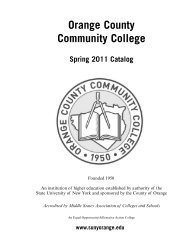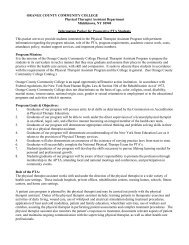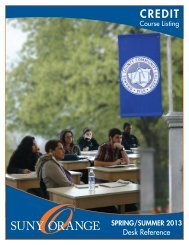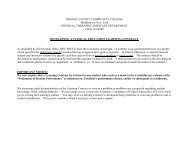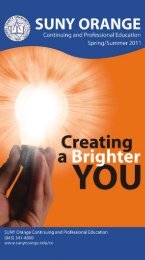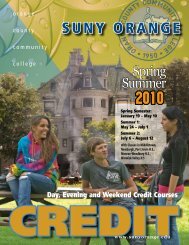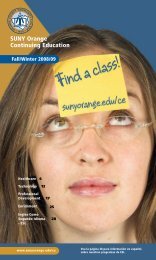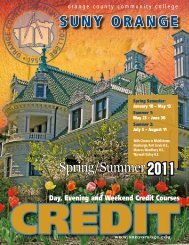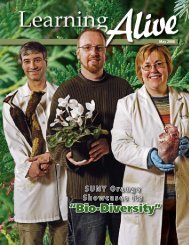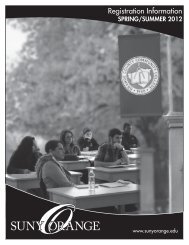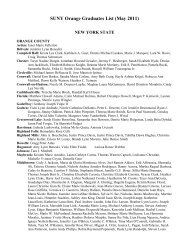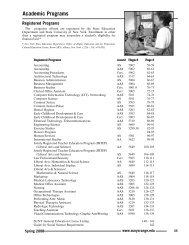You also want an ePaper? Increase the reach of your titles
YUMPU automatically turns print PDFs into web optimized ePapers that Google loves.
Biology<br />
Biology<br />
(Biology Department)<br />
Biological Science majors must take BIO 101 and<br />
BIO 102. Then select from BIO 201, BIO 202, BIO<br />
204 or BIO 205. Students should consult with a<br />
biology department advisor.<br />
BIO 101—General Biology 1<br />
3 lect., 3 lab., 4 cr. (Fall/Summer)<br />
Topics include a study of the nature and scope of<br />
science in general and biological science in particular:<br />
the chemical and physical basis of life; the structures<br />
and functions of the cell with an emphasis on<br />
photosynthesis, respiration, functions of DNA, and<br />
the processes of mitosis and meiosis. The course<br />
concludes with the genetic and evolutionary<br />
consequences of meiosis and reproduction. (GE 2)<br />
BIO 102—General Biology 2<br />
3 lect., 3 lab., 4 cr. (Spring)<br />
A study of the plant and animal organism with an<br />
emphasis on the vertebrate animal and the flowering<br />
plant. Comparative systems are studied. The<br />
relationships between organisms and the environment<br />
are also covered. (GE 2)<br />
Prerequisite: BIO 101<br />
BIO 110—Introduction to Biology<br />
2 lect., 3 lab., 3 cr. (Fall/Spring/Summer)<br />
A introductory course covering the scientific<br />
method, basic chemistry, cell biology, structure and<br />
function of the vertebrate body, biochemical<br />
pathways, cellular division, genetics, diversity and<br />
biological systems. (GE 2)<br />
Prerequisite: The course is designed for students with<br />
little or no academic background in biological sciences<br />
and want to pursue a career in the health professions or<br />
biology.<br />
BIO 111—Anatomy and Physiology 1<br />
3 lect., 3 lab., 4 cr. (Fall/Spring/Summer)<br />
An introduction to the structure and function of<br />
human systems. Study begins with the organization of<br />
the body from the molecular to the organ/organ<br />
system level of function and continues through the<br />
Integumentary, Skeletal, Muscle, Nervous and<br />
Endocrine systems. Laboratory work includes cellular<br />
structure and function, histology, and gross<br />
anatomical analysis of the skeletal, muscular, and<br />
nervous systems. The laboratory experience includes<br />
use of human bones and dissection of the cat, sheep<br />
eye and brain as well as use of human anatomical<br />
models of organs and structures related to the above<br />
systems.<br />
Prerequisite: AP Biology, BIO 110 or BIO 101 and<br />
BIO 102<br />
BIO 112—Anatomy and Physiology 2<br />
3 lect., 3 lab., 4 cr. (Fall/Spring/Summer)<br />
Continues the study of the structure and function of<br />
human systems begun in BIO 111 (Anatomy and<br />
Physiology 1). Included are the Circulatory,<br />
Lymphatic, Immune, Respiratory, Digestive, Urinary<br />
and Reproductive systems. Acid-base, fluid and<br />
electrolyte balance are also discussed, and functional<br />
inter-relationships and homeostasis are stressed<br />
throughout. Laboratory work includes analysis of the<br />
structure and function of the above systems at the<br />
histological, gross anatomical and organ system<br />
levels. The laboratory experience includes dissection<br />
of the cat and beef and sheep hearts as well as<br />
prepared histological specimens, human anatomical<br />
models and computer/video presentations related to<br />
the above systems. Laboratory experiments also<br />
expose students to related clinical techniques/ topics<br />
such as blood typing, ECG, blood pressures, pulse<br />
determination, heart and lung sounds, spirometry,<br />
and urinalysis.<br />
Prerequisite: BIO 111<br />
BIO 113—Neurobiology<br />
2 lect., 2 lab., 3 cr. (Fall)<br />
This course is designed for students of Massage<br />
Therapy, Physical Therapist Assistants, Occupational<br />
Therapy Assistants, and other Health Sciences. It will<br />
provide the student with a foundation for<br />
understanding neurological dysfunction. Integration,<br />
rather than segregation, between structure and<br />
function are emphasized. This course will enable the<br />
student to be conversant in the structure and function<br />
of the nervous system, with emphasis on<br />
sensorimotor integration and neuromuscular<br />
physiology. The organizing theme is the regulation of<br />
body function, how the nervous system is influenced<br />
during development, learning, and by disease, or<br />
trauma. This is illustrated in a multidisciplinary<br />
fashion: morphology, physiology, biochemistry and<br />
clinical manifestations. Examples of pathological,<br />
occupational and environmental causes of<br />
neurological disease are highlighted through lectures<br />
and student presentations. The different approaches<br />
used in diagnosis and understanding physical<br />
impairment are stressed as essential components of<br />
devising effective therapy.<br />
Prerequisite: BIO 112<br />
BIO 115—Human Biology<br />
3 lect., 3 lab., 4 cr. (Fall)<br />
Human anatomy, physiology and pathology are<br />
discussed in lectures. Laboratory work includes<br />
microscopic study of tissues and a dissection of the<br />
cat. The anatomy of the cat is correlated with human<br />
anatomy.<br />
Prerequisite: BIO 110 or BIO 101<br />
174 www.sunyorange.edu Spring 2012




